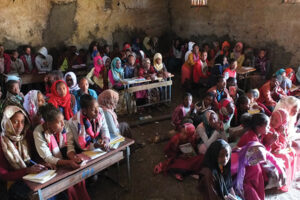At imagine1day, any school we build is done in partnership with the community: right down to the financial costs. To ensure local ownership and pride, we ask the communities themselves to contribute at least 10% of the construction costs.
The burgeoning community of Hora Boqa – with 1,696 school aged children – did just that, and then some.
After raising the minimum $12,000, they carried on – eventually amassing a truly impressive $42,000. They sold animals, crops, and land to put together the colossal sum – in a country where the average adult income is $550 a year, and noticeably lower in rural communities.
It is a true indicator of the sense of excitement and determination the community has for education.
Right now, just half of the school-aged children are enrolled. A lack of classrooms mean there is simply not space for everyone to attend. For those that do, they experience run-down mud-constructed buildings, that offer little protection from the elements, particularly in the rainy season, when water floods the dirt floor, attracting flees and other infectious bugs in the process.
Belete, 14, pictured above with his little brother, is one of the students dealing with the difficult conditions: “Our classroom gets muddy when it rains and so dusty during the dry season. It is not comfortable at all,” he says.

Hora Boqa fundraised more money locally, so children won’t have to endure classrooms like this.
There are many schools in need across Ethiopia, and we had to make a difficult choice: We told the community we could build a school with four classrooms, but no more. With 1,700 students, that meant many would have to continue to endure the poor learning environments.
The community took matters into their own hands – raising more money locally than any school we’ve worked with to date.
Their commitment will pay off: This year, with the support of donors and the community’s impressive contribution, we are building eight classrooms, along with a library, early childhood education classroom, playground and gender-segregated latrines.

